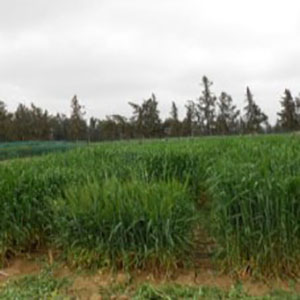Durum wheat salt stress tolerance is modulated by the interaction between plant genotypes, soil microbial biomass, and enzyme activity

Accepted: 5 January 2022
Appendix: 59
HTML: 14
All claims expressed in this article are solely those of the authors and do not necessarily represent those of their affiliated organizations, or those of the publisher, the editors and the reviewers. Any product that may be evaluated in this article or claim that may be made by its manufacturer is not guaranteed or endorsed by the publisher.
Understanding the relationship between durum wheat genotypes and soil biochemistry under salt stress plays a key role in breeding for yield superior genotypes. Thus, microbial biomass carbon (MBC) and nitrogen (MBN), the activity of three selected enzymes including dehydrogenase (D-ase), alkaline phosphatase (Alk-ase), and protease (P-ase), and available phosphorus (available P) and nitrogen (available N) were assessed. Two landraces and two improved varieties were tested under two salinity levels of water irrigation (0.3 and 12 dS m–1). Soil sampling was carried out at five durum wheat growth stages. The soil biota-genotype interaction seems to affect the biological (MBC, MBN, and enzymatic activities) and chemical (available P and N) traits. The microbial activity of rhizospheric soil was higher at the tillering and flowering stages. Under saline conditions, ‘Maali’ (improved variety) and ‘Agili Glabre’ (landrace) showed the best belowground inputs (e.g., MBC, MBN, enzymatic activities, available P and N) and grain yield (GY) performance. Under the same conditions, four soil biochemical indicators of GY of tolerant genotypes (i.e., ‘Maali’ and ‘Agili Glabre’) were determined as available N, P-ase, available P, Alkase, and D-ase. Stepwise analysis revealed that predictive variables depended on growth stages. Overall, MBC, available N, Alk-ase, and P-ase were the variables that mainly contributed to predicting GY in saline environments. In conclusion, the results suggested a specific interaction between plant genotype roots and soil microbes to overcome salt stress. Thus, soil biological components should acquire more importance in plant salinity tolerance studies.
Highlights
- Salt-tolerant durum wheat genotypes showed greater microbial activities in the rhizosphere.
- Microbial enzymatic changes depended on the interaction plant genotype x soil salinity.
- The MBC/MBN ratio and dehydrogenase strongly correlated with grain yield under salinity.
- MBC, available N, and alkaline phosphatase as predictors of grain yield at 12 dS m–1.
- Tillering and flowering could be key stages of durum wheat salinity tolerance.
How to Cite

This work is licensed under a Creative Commons Attribution-NonCommercial 4.0 International License.
PAGEPress has chosen to apply the Creative Commons Attribution NonCommercial 4.0 International License (CC BY-NC 4.0) to all manuscripts to be published.

 https://doi.org/10.4081/ija.2022.1942
https://doi.org/10.4081/ija.2022.1942







